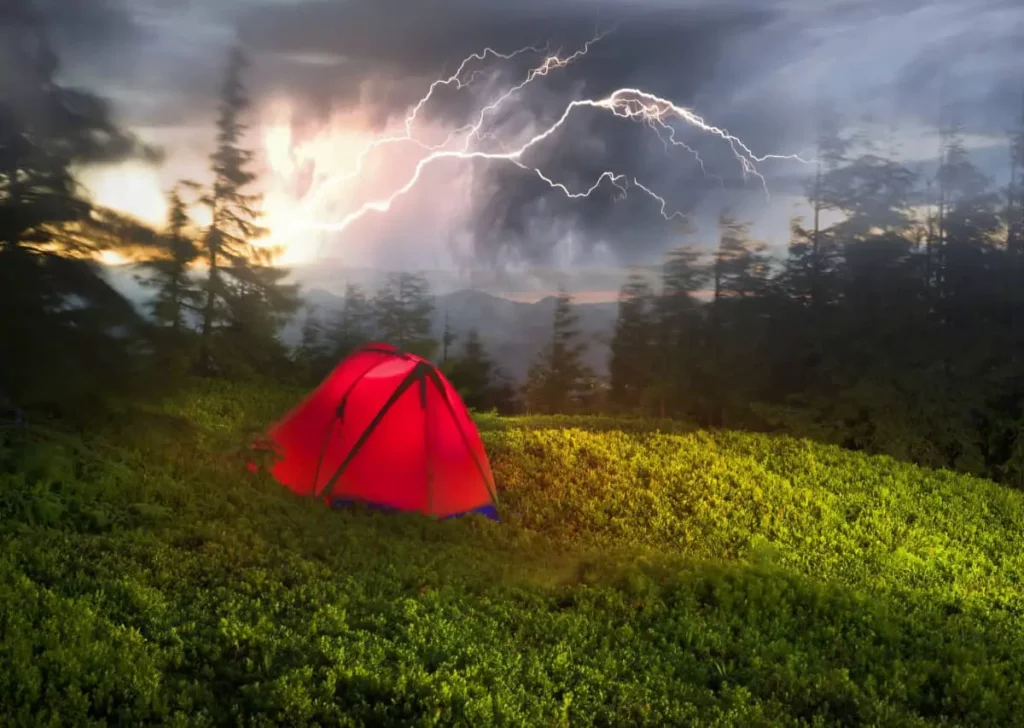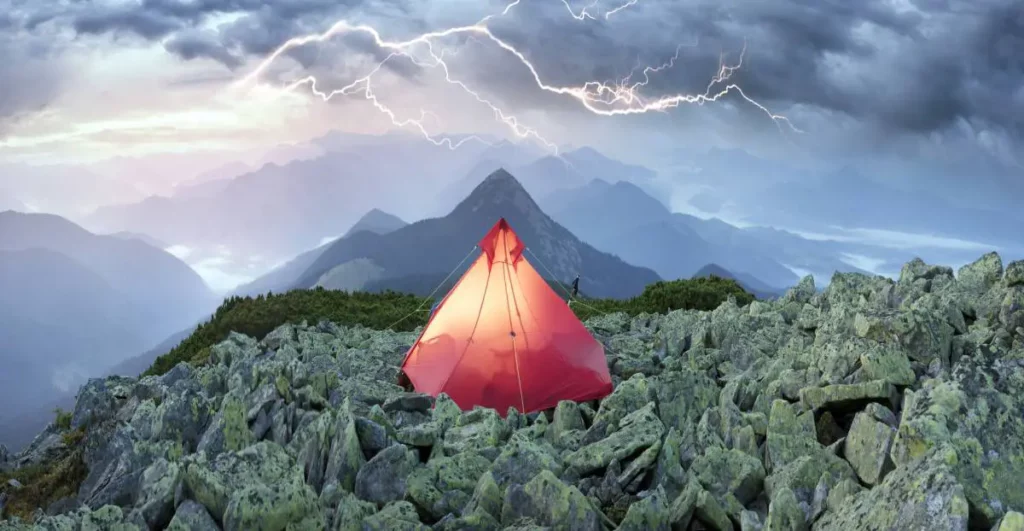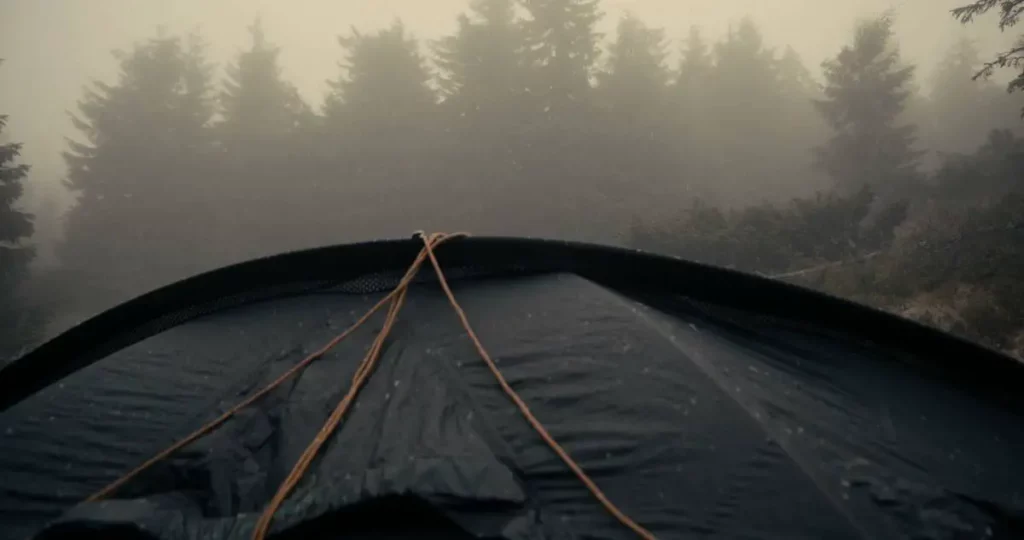This post contains affiliate links.
Watching and hearing a thunderstorm can be a thrilling experience in the safety of your home, but when you’re stuck inside a tent in the thralls of torrential winds and lightning strikes, the thrill quickly diminishes.
Tents will not protect you from lightning strikes during a storm; in fact, the aluminum piping used to hold a tent’s shape is a conductor of electricity. In addition, a tent may flood during a downpour if it is pitched below the area’s water level, which can lead to drowning or other dangerous conditions.
It is vital that you understand the potential dangers you may face while out camping during a thunderstorm, so you know what to be prepared for. Keep track of any weather changes, and know where around your camping location can be a safe shelter during hazardous weather conditions.

Table of Contents
Potential Dangers During Thunderstorms
When you are camping in the wilderness, many potential dangers can make a controllable situation turn into chaos during a severe storm, including flooding, high winds, and lightning strikes.
Flooding
Flooding is common during heavy rainfall; flash flooding, in particular, can occur without warning and carry immense currents in the right conditions.
If you’re inside a tent during a torrential downpour and resulting flood, there is a danger of drowning, especially if your campsite is within the area’s flood plain. In addition, getting caught in high water will leave you soaking wet, and at risk of hypothermia in colder environments. Finally, there is the danger of being exposed to harmful bacteria and microorganisms in standing water.
High Winds
Trees may be a beautiful sight to take in and enjoy the fresh oxygen they provide us, but during a severe storm, they are no longer your allies.
With heavy wind gusts, large, overhanging tree limbs are susceptible to breaking and snapping off. If you are camping relatively near trees, there is a chance that you could be injured from flying debris such as branches. In extremely high winds, weaker trees may end up falling, and the last place you want to be when this happens is inside of your tent nearby.
Lightning Strikes
Finally, the last and the most dangerous situation you can face during a thunderstorm is lightning strikes.
Lightning strikes were the cause of 20 deaths in 2018, and affect 10% of the US population per year. Being caught in a thunderstorm increases your chances of being a victim of lightning strikes.
The most common forms of lightning-related injuries are side flashes and ground currents, though if you are camping out in the open or the woods, you also put yourself at risk of direct strikes and contact injuries.
- Direct Strike – This occurs when lightning strikes an individual directly. In most cases, this can be fatal.
- Contact Injury – This form of lightning damage happens when a person makes contact with an object that has recently been struck by lightning.
- Side Flash – Also known as side splash, this is a variation of the direct lightning strike. This occurs when lightning strikes a taller object and jumps to a person or animal within a few feet away. Side flash is more likely to occur if you are taking shelter under a tree, standing by a fence or pole, or are inside a tent that is struck by lightning. 31% of lightning strike casualties are caused by side flashes.
- Ground Current – A ground current is an indirect lightning strike. If an object is struck by lightning, it could send the electrical charge down into the ground. The current will surge out from the contact point through the ground’s surface, electrocuting anything in the vicinity. Ground currents are the cause of most lightning casualties.

Locations to Avoid During a Thunderstorm
When an unexpected storm rolls up on your camping trip you’ll find yourself in a mad scramble to take your tent down in the rain (link to our article for tips on taking down a tent in the rain) and head for a safer location.
There are a few different places and things you should avoid during a severe storm, regardless of whether you are front-country or backcountry camping:
- Front-country camping is when you are camping near civilization; recreational campsites are typical examples of front country. Most campgrounds will have running water, restrooms, and service centers that are permanent structures. Front-county camping will provide you with a higher chance of finding safe refuge during a storm.
- Backcountry camping is when you are at least 30 miles from civilization. Backcountry camping will leave you exposed to the elements and requires quick decision making to stay safe. There is little to no protection from lightning when camping in the backcountry.
Depending on where you camp, you may or may not encounter the following items and locations, but if you do, it is vital to stay as far away from them as possible for your safety.
Areas with Metallic Objects
Many front-country areas will be filled with metal signposts and fences; these objects are long conductors of electricity and prone to lightning strikes. If you come across either of these items or other metallic structures during a thunderstorm, make sure you stay at least 20 feet away from them; otherwise, you risk exposure to side flashes, ground currents, and contact injuries if they are ungrounded.
Areas with Isolated or Tall Trees
Locations with isolated or tall trees are dangerous because of the higher potential for lightning strikes. Generally, trees hold water as reserves, and their root system acts as a natural circuit for electricity to flow to ground. Tall trees commonly contribute to side flash and ground current injuries.
If you are camping in a forest during a storm, look for shorter trees with as few branches as possible; this ensures that you reduce the risk of getting hit by broken limbs in high winds.
Open Fields or Mountaintops
An open field or mountain is equally as dangerous to be near during a thunderstorm. Lightning strikes taller objects, and in the case of either location, you are the closest point for a direct strike.
Floodplains
Finally, avoid areas prone to flooding. In some front-country regions, there may be signage that lets you know which portions of a campsite are below the flood level, but if not, pick a site that appears to be on higher ground. During a severe storm, make sure you move away from rivers, ponds, or other sources of water that could overflow your tent and surrounding areas.

Actions to Take to Avoid Injury
Knowing when and where to seek refuge is the key to avoiding injury during a severe thunderstorm. In general, they say that “when thunder roars, head indoors,” but this may not always be possible if you are camping deep in the woods or in another secluded area. So, the following are some steps you can take to reduce your chances of injury during a severe storm:
- If you are front-country camping, find the nearest accessible building or enclosed space. The large openings and exposed metal of tents and pavilions do not offer adequate protection from lightning and flooding. Find an indoor space and stay there until at least 30 minutes after the storm has passed.
- If you are in the backcountry or an area where there are no buildings to take refuge in, an enclosed vehicle can work just as well. Likewise, stay inside the car until at least 30 minutes after the storm has passed over the region. Make sure that if you do choose to stay in a vehicle that it is moved away from tall trees.
- If you are in the middle of a climb up a mountain, head back down to low land that does not have a body of water nearby. A deep cave or rock enclosure on a hill can be an adequate place of safety as well.
- If you find yourself in an area where you are exposed, such as an open field, or can’t get back down a mountain quickly enough, squat down with your head between your knees. As silly as this may sound, it helps reduce your surface area on the ground and significantly limits the probability of attracting a direct strike. Make sure you do not lay on the ground; this actually increases your surface area and puts you at risk for being injured by ground currents.
- Stay at least 20 feet away from other members of your camping party. Ground currents can travel a good distance, and creating substantial distance between you and other campers ensures that in case of someone being a victim of a lightning strike, the current will not transfer to others nearby.
Preparing For Bad Weather
No matter what the forecast say it’s always important to prepare for rain and nasty weather conditions when heading into the backcountry or just to a local campground.
One of the main steps is to make sure your tent and rainfly are properly waterproofed every season. This can be done by setting up your tent and applying a waterproofing spray to the exterior walls, roof, floor and rainfly.
After a few seasons of use, prolonged UV exposure and long periods of storage the factory waterproofing coating can wear down. It’s important to test for any leakage before your trip so you’re not left sleeping in a puddle. Keeping the gear you bring tent camping dry will also help them last longer and remain in top condition.
- ULTIMATE PROTECTION FOR OUTDOOR FABRICS - Waterproofing plus UV and stain protection for boat covers, car covers, bimini tops, sail covers,...
- PRESERVES FABRIC QUALITY - Does not change the breathability, color, or feel of fabric, ensuring original texture and appearance
- EXTENDS FABRIC LIFE - Great for use on new fabrics, greatly extending their service life and revives old fabrics by providing an additional...
Closing Thoughts
Weather patterns are as uncontrollable as life itself. One moment the sky is clear, and the sun is out, and in the next dark skies swirl overhead, the temperature drops, and the air starts to buzz. If you notice any of these signs of an incoming thunderstorm as you camp, it is best to retreat to a place of safety, such as in an enclosed structure away from trees, water, and metallic objects, rather than stay inside your tent.
In the end, prevention is always best; as long as you monitor the weather leading up to and during your camping trip and have an emergency plan in place should the worst happen, you can significantly improve your chances of coming out of the other side of a storm scratch-free.
Related Articles
How To Take Down A Tent In The Rain

